The Great Equalizer Part 2: Surface Pro vs. Android Devices in 3DMark
by Anand Lal Shimpi on April 2, 2013 2:26 PM EST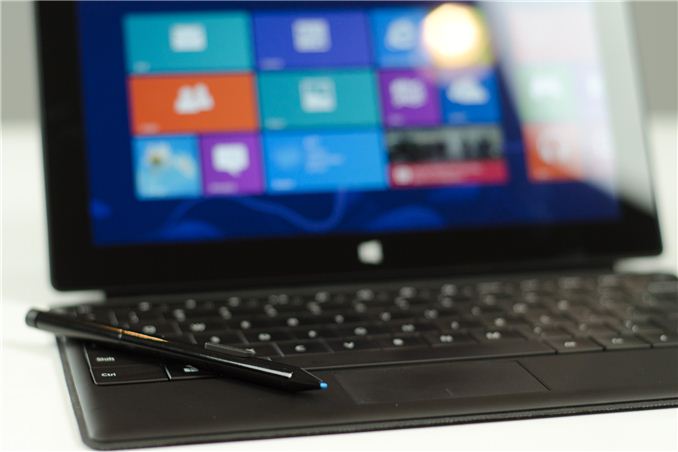
While we're still waiting for Windows RT and iOS versions of the latest 3DMark, there is one cross-platform comparison we can make: Ivy Bridge/Clover Trail to the Android devices we just tested in 3DMark.
The same caveats exist under 3DMark that we mentioned in our GL/DXBenchmark coverage: not only is this a cross-OS comparison, but we're also looking across APIs as well (OpenGL ES 2.0 for Android vs. Direct3D FL 9_1 for Windows). There will be differences in driver maturity not to mention just how well optimized each OS is for the hardware its running on. There are literally decades of experience in optimizing x86 hardware for Windows, compared to the past few years of evolution on the Android side of the fence.
Absent from these charts is anything running on iOS. We're still waiting for a version of 3DMark for iOS unfortunately. If our previous results are any indication however, Qualcomm's Adreno 320 seems to be hot on the heels of the GPU performance of the 4th generation iPad:
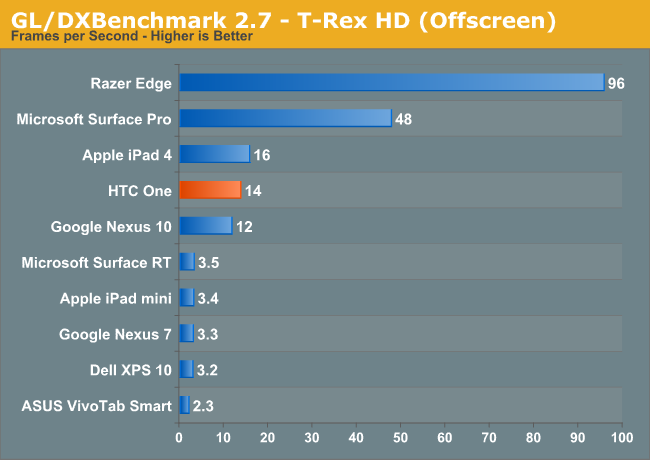
In our GL/DXBenchmark comparison we noted Microsoft's Surface Pro (Intel HD 4000 graphics) managed to deliver 3x the performance of the 4th generation iPad. Will 3DMark agree?
All of these tests are run at the default 720p settings. The key comparisons to focus on are Surface Pro (Intel HD 4000), VivoTab Smart (Intel Clover Trail/SGX 545) and the HTC One (Snapdragon 600/Adreno 330). I've borrowed the test descriptions from this morning's article.
Graphics Test 1
Ice Storm Graphics test 1 stresses the hardware’s ability to process lots of vertices while keeping the pixel load relatively light. Hardware on this level may have dedicated capacity for separate vertex and pixel processing. Stressing both capacities individually reveals the hardware’s limitations in both aspects.
In an average frame, 530,000 vertices are processed leading to 180,000 triangles rasterized either to the shadow map or to the screen. At the same time, 4.7 million pixels are processed per frame.
Pixel load is kept low by excluding expensive post processing steps, and by not rendering particle effects.
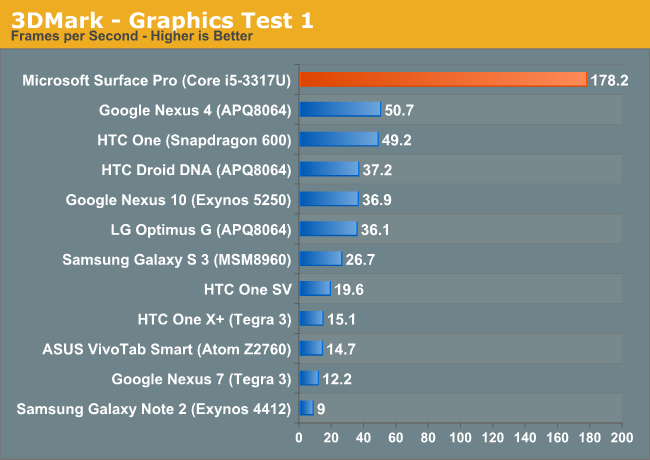
In this mostly geometry bound test, Surface Pro does extremely well. As we saw in our GL/DXBenchmark comparison however, the ARM based Android platforms don't seem to deliver the most competitive triangle throughput.
Graphics Test 2
Graphics test 2 stresses the hardware’s ability to process lots of pixels. It tests the ability to read textures, do per pixel computations and write to render targets.
On average, 12.6 million pixels are processed per frame. The additional pixel processing compared to Graphics test 1 comes from including particles and post processing effects such as bloom, streaks and motion blur.
In each frame, an average 75,000 vertices are processed. This number is considerably lower than in Graphics test 1 because shadows are not drawn and the processed geometry has a lower number of polygons.
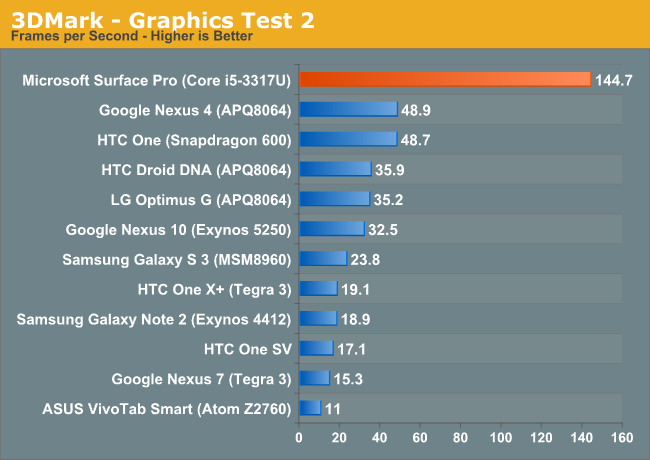
The more pixel shader bound test seems to agree with what we've seen already: Intel's HD 4000 appears to deliver around 3x the performance of the fastest ultra mobile GPUs, obviously at higher power consumption. In the PC space a 3x gap would seem huge, but taking power consumption into account it doesn't seem all that big of a gap here.
Physics Test
The purpose of the Physics test is to benchmark the hardware’s ability to do gameplay physics simulations on CPU. The GPU load is kept as low as possible to ensure that only the CPU’s capabilities are stressed.
The test has four simulated worlds. Each world has two soft bodies and two rigid bodies colliding with each other. One thread per available logical CPU core is used to run simulations. All physics are computed on the CPU with soft body vertex data updated to the GPU each frame. The background is drawn as a static image for the least possible GPU load.
The Physics test uses the Bullet Open Source Physics Library.
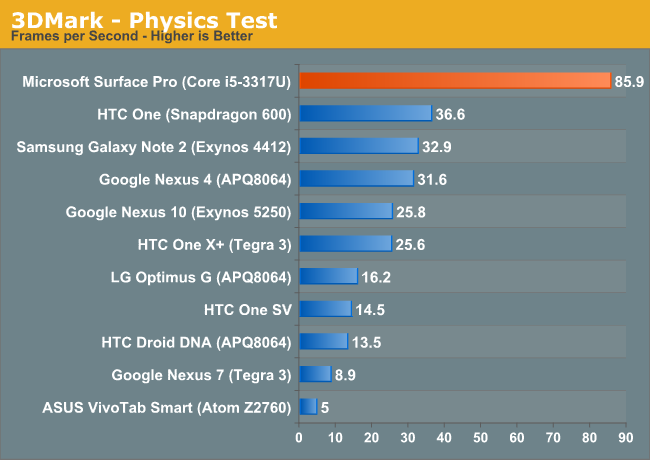
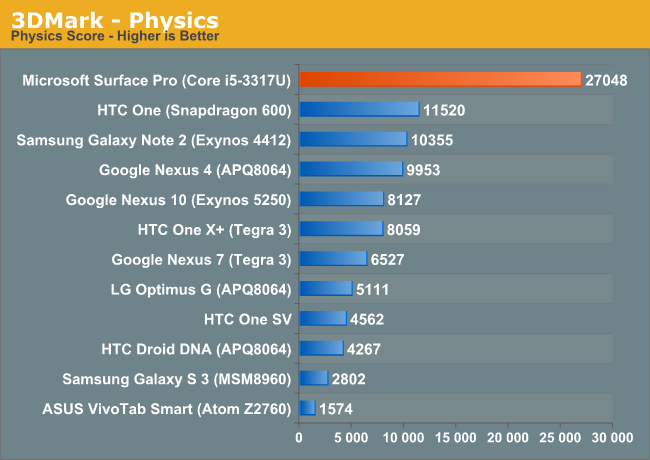
Surprisingly enough, the CPU bound physics test has Surface Pro delivering 2.3x the performance of the Snapdragon 600 based HTC One. Quad-core Cortex A15 based SoCs will likely eat into this gap considerably. What will be most interesting is to see how the ARM and x86 platforms converge when they are faced with similar power/thermal constraints.
What was particularly surprising to me is just how poorly Intel's Atom Z2560 (Clover Trail) does in this test. Granted the physics benchmark is very thread heavy, but the fact that four Cortex A9s can handily outperform two 32nm Atom cores is pretty impressive. Intel hopes to fix this with its first out-of-order Atom later this year, but that chip will also have to contend with Cortex A15 based competitors.
Ice Storm - Overall Score
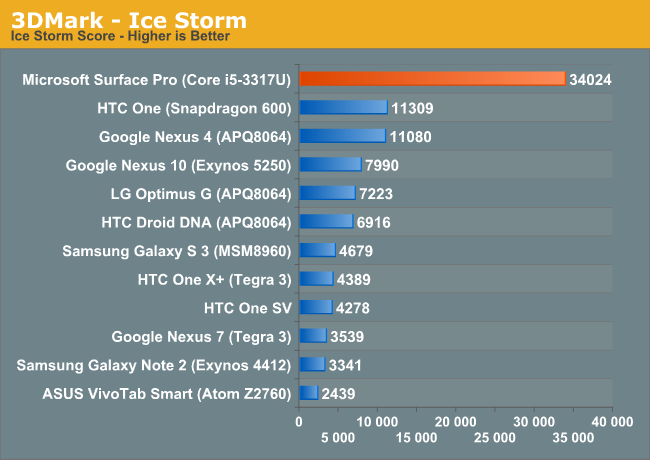
The overall score seems to agree with what we learned from the GL/DXBenchmark comparison. Intel's HD 4000 delivers around 3x the graphics performance of the leading ultra mobile GPUs, while consuming far more power. Haswell will drive platform power down, but active power should still be appreciably higher than the ARM based competition. I've heard rumblings of sub-10W TDP (not SDP) Haswell parts, so we may see Intel move down the power curve a bit more aggressively than I've been expecting publicly. The move to 14nm, and particularly the shift to Skylake in 2015 will bring about true convergence between the Ultrabook and 10-inch tablet markets. Long term I wonder if the 10-inch tablet market won't go away completely, morphing into a hybird market (think Surface Pro-style devices) with 7 - 8 inch tablets taking over.
It's almost not worth it to talk about Clover Trail here. The platform is just bad when it comes to graphics performance. You'll notice I used ASUS' VivoTab Smart here and in the GL/DXBenchmark comparison instead of Acer's W510. That's not just because of preference. I couldn't get the W510 to reliably complete GL/DXBenchmark without its graphics driver crashing. It's very obvious to me that Intel didn't spend a lot of time focusing on 3D performance or driver stability with Clover Trail. It's disappointing that even in 2012/2013 there are parts of Intel that still don't take GPU performance seriously.
The next-generation 22nm Intel Atom SoC will integrate Intel's gen graphics core (same architecture as HD 4000, but with fewer EUs). The move to Intel's own graphics core should significantly modernize Atom performance. The real question is how power efficient it will be compared to the best from Imagination Tech and Qualcomm.


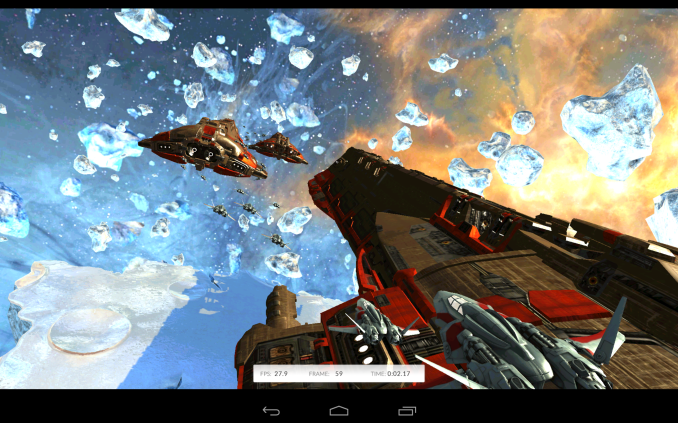










56 Comments
View All Comments
zeo - Tuesday, April 16, 2013 - link
Easily explainable... Intel only recently got serious about penetrating the mobile market. The ATOM was originally on a very slow 5 year product cycle and it's just over 5 years now!However, the upcoming Bay Trail marks the switch to a two year tic-toc product cycle... along with the first major architectural update as they're finally switching from In Order Processing to Out of Order and will offer quad cores and support for up to 8GB of RAM with a full 64bit implementation.
They still have a lot to prove but it does look like they're finally getting serious about this, especially since they're pushing technology first introduced with Ivy Bridge to the ATOM with this release.
In the meantime, Intel is upping the graphical performance a bit with the Clover Trail+ as that one will use a GMA based on dual 544 PowerVR GPU at 533MHz... should provide much more decent graphical performance until Bay Trail starts coming out by the end of this year, and on through early next year.
lorribot - Tuesday, April 2, 2013 - link
Would be interesting to see how AMD's lowest power offering does.Ewram - Tuesday, April 2, 2013 - link
Agreed, need some AMD numbers!kyuu - Tuesday, April 2, 2013 - link
+1duploxxx - Wednesday, April 3, 2013 - link
agree, but OEM will never use it that much, they prefer to stick to fooling consumers with lots of marketing djingles that they buy the best brand in blue, Temash would be a way better fit then atom. It has low power usage , cpu power and gpu power and probably be cheaper in total...zeo - Tuesday, April 16, 2013 - link
Cheaper, no... Intel SoCs are barely more costly than ARM SoCs and that's about as low as they get.Temash, though, should offer more performance, especially graphically... However, it's still a generation longer before AMD can really compete for mobile device range power efficiency.
Like aside from S3 suspend state, there's no support for features like always connected standby and idling doesn't go as low as ARM and ATOM SoCs can go.
The dual core Temash is the only one that can go fan-less but it will still consume more power than the average mobile tablet. While the quad core will still consume significantly more and will require a fan but it will also offer a higher performance range, especially when docked as then it can enter a Turbo mode of 14W max TDP for more Ultrabook range performance.
oaso2000 - Wednesday, April 3, 2013 - link
Here's what I got on my computer:AMD E-350
Windows 7 x64
3DMark Score: 13143 3DMarks
Graphics Score: 15173
Physics Score: 8953
Graphics Test 1: 71.9 FPS
Graphics Test 2: 61.0 FPS
Physics Test: 28.4 FPS
kyuu - Thursday, April 4, 2013 - link
Thanks for posting that oaso2000. I also went to the 3DMark website and looked at one of the results for a C-60 system, as the scores should be similar for the Z-60 (AMD's tablet APU). These are the results:3DMark Score: 10880 3DMarks
Graphics Score: 13461
Physics Score: 6511
Graphics Test 1: 63.0 FPS
Graphics Test 2: 54.7 FPS
Physics Test: 20.7 FPS
So, assuming those numbers are accurate, it looks like the Z-60 lags behind the newest ARM SoCs in terms of CPU performance, though not by a whole lot. GPU-wise, it's still ahead everything in the charts, bar the HD4000 in the Surface Pro.
This confirms my suspicion that even the Z-60 (which should be greatly improved upon by Temash) is a much, much superior tablet solution than Clover Trail. God damn OEMs going for Intel silicon when the AMD solution is better *and* almost certainly cheaper.
63jax - Thursday, April 11, 2013 - link
i ask the same question! even if AMD will pull out a monster, the OEMs will still not adopt it, something is still very fishy there.cmdrdredd - Tuesday, April 2, 2013 - link
Does anyone else think that if battery tech would keep up then we wouldn't need to be worrying about power usage so much?